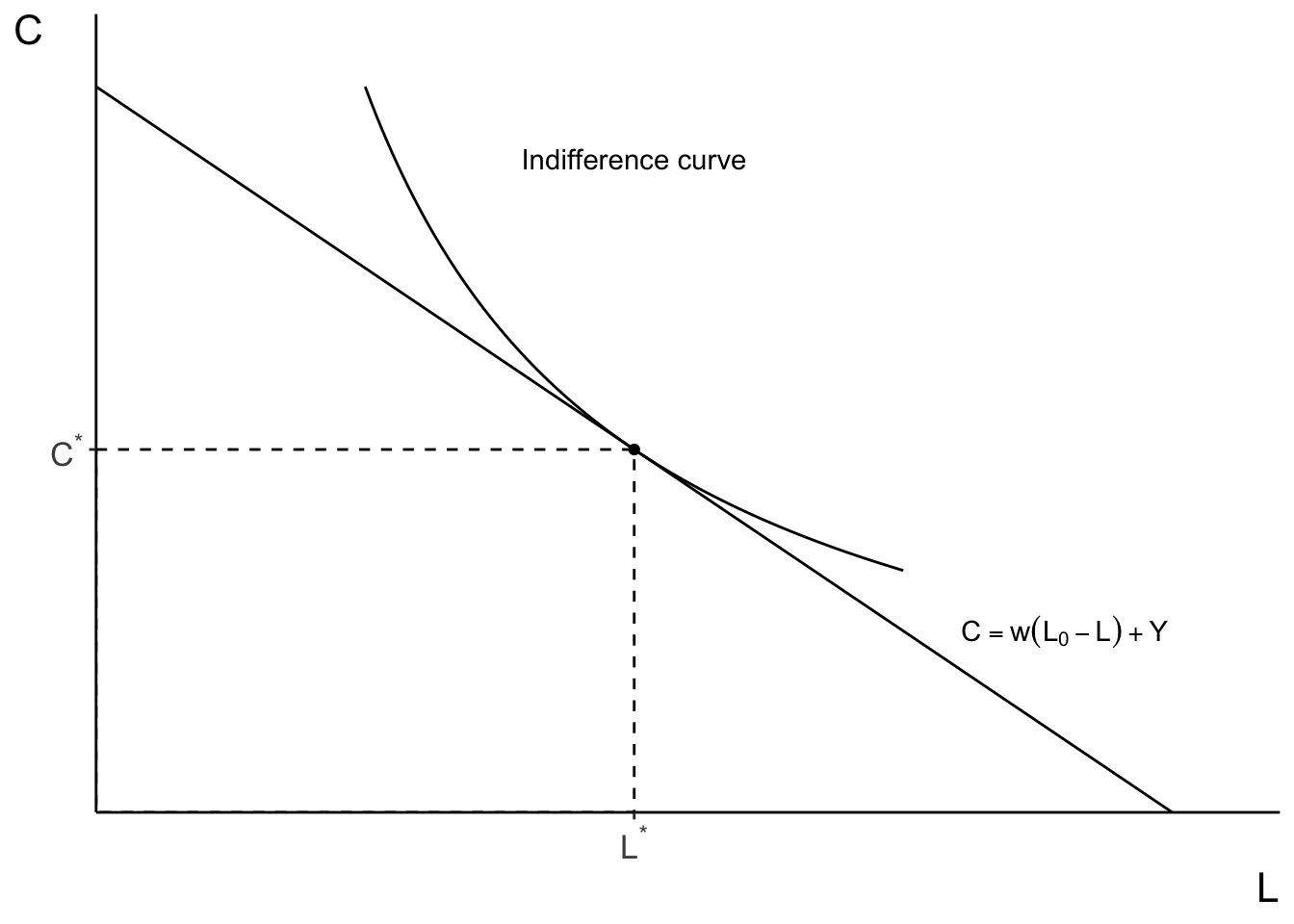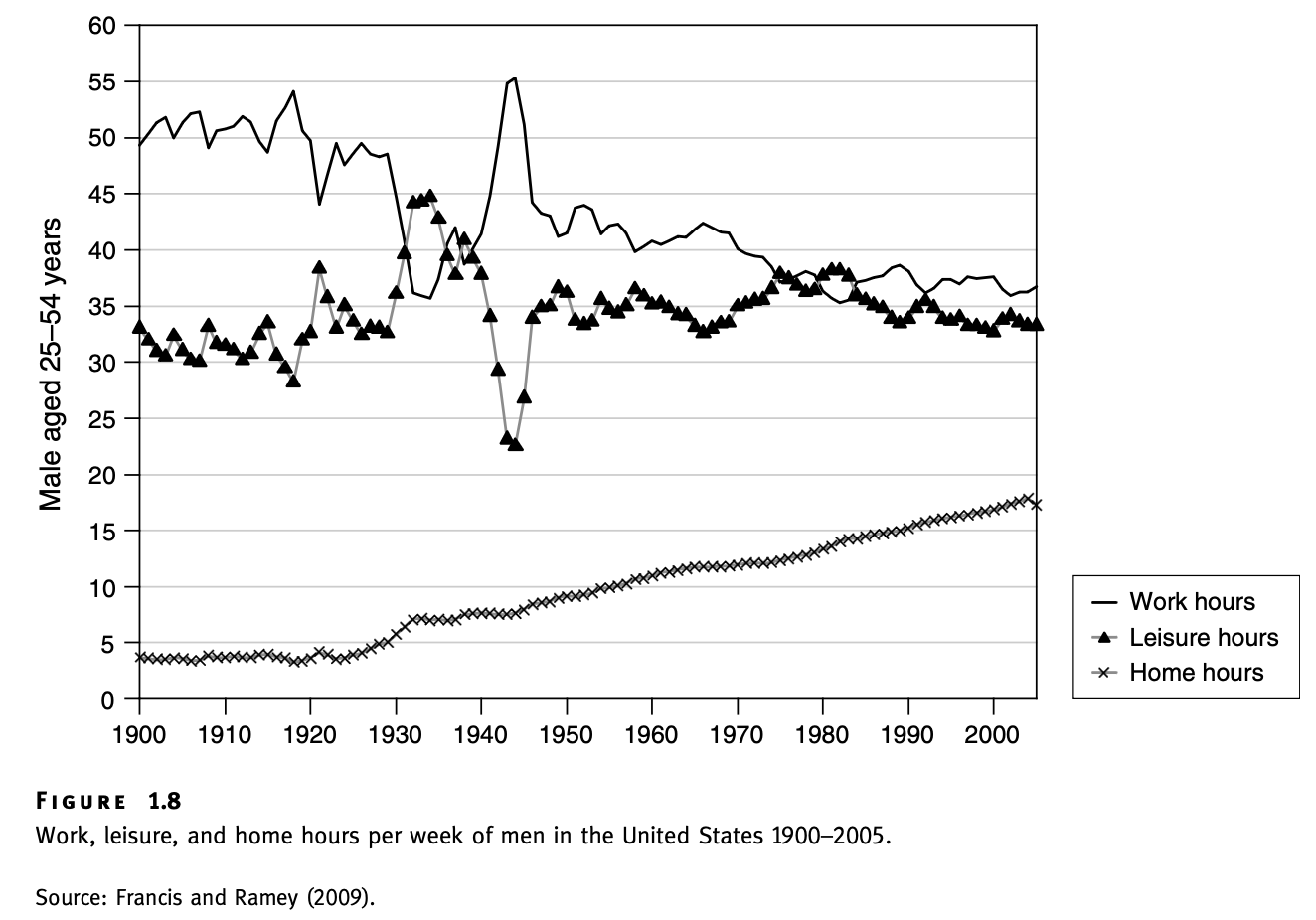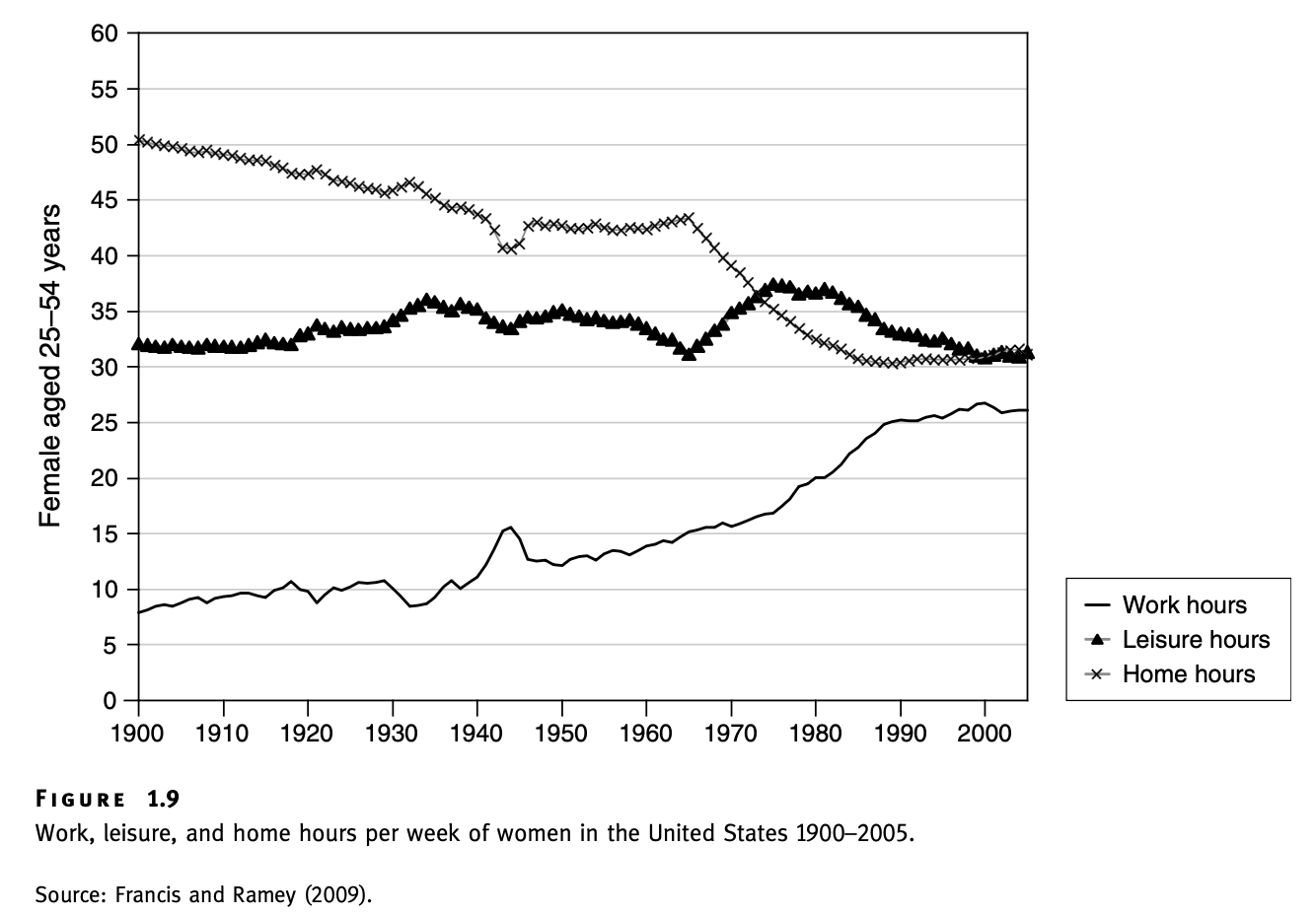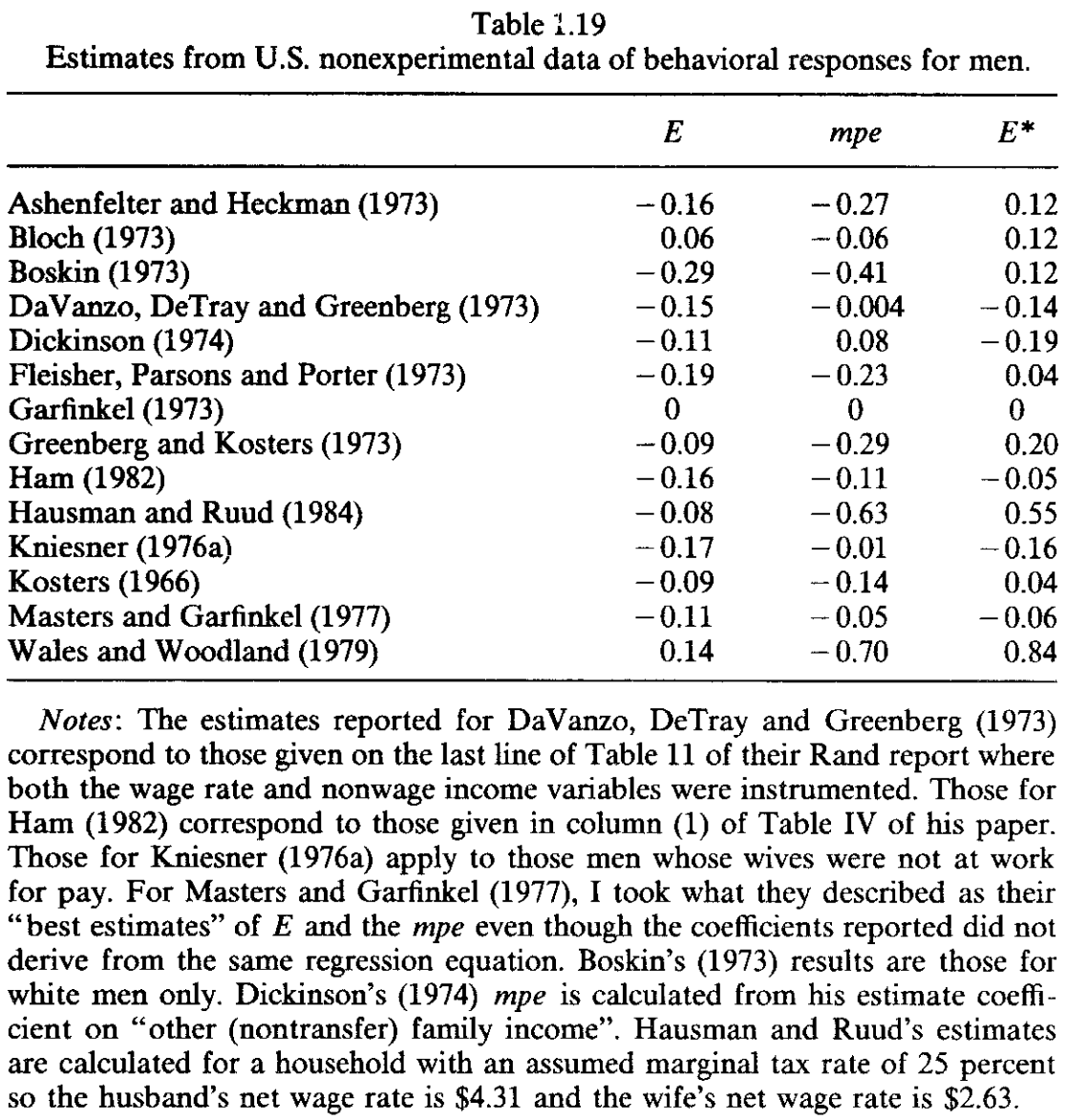
2. Labour Supply
KAT.TAL.322 Advanced Course in Labour Economics
Labour supply
How people choose
- whether to work, and
- how much to work
Static model
Static labour supply
Model
- Utility from consumption of goods (
- Total time endowment
- Agent chooses
- Budget constraint is
- In economics, the tradeoffs arise from finite resources. Hence, we need to find the best way to allocate that finite resource.
- In the case of a worker making decisions, the finite resource is her time (
- The individual can devote all her time to working to maximise earnings. But that clearly is undesirable because she would then not enjoy any recreation time and will not be performing other every day activities (home production).
- She could also devote all her time to leisure and home production. That too would be undesirable because these activities do not earn wages, so she would not be able to consume much.
- So, she needs to find an optimal time she wants to devote to work
- This is the most standard model of labour supply used as the basis for many other extensions (such as wealth accumulation, occupation choice, family formation, even criminal activity). Despite its simplicity, it can illustrate the tradeoffs well and inform our interpretation of the real world.
Static labour supply
Allocation of time in the data


Ramey and Francis (2009) study the evolution of average work, leisure and home production hours throughout the XX century.
- Work hours have increased markedly for women and declined for men.
- However, total number of hours devoted to work has declined slightly over the same years (see figure in Ramey and Francis (2009)).
- Despite this the leisure hours have not changed much.
- Instead, the dynamics in work hours seem to be reflected in the dynamics of the home production hours: women have decreased time devoted to home production, while men increased.
- The change seems to be symmetric so that the total amount of time spent on home production across both sexes remained roughly similar over the years.
- There was also noticeable increase in the time spent on education (not shown in the graphs).
Static labour supply
Solution
First-order conditions of the Lagrangian are
Solution pair
Typical way to solve constrained optimisation problem is to set up a Lagrangean.
Now, we can take first-order derivaties with respect to
Hence, first-order conditions (FOCs) are as presented on the slide. We can now divide the two FOCs to get the optimality condition
Static labour supply
Solution
The solution can be depicted graphically in the
- The straight line is the budget line: it traces all combinations of
- The curve is indifference curve: it traces all combinations of
- The optimal solution lies at the point of tangency of two curves: the combination of
Static labour supply
Comparative statics
How does optimal labour supply change with
Marshallian (uncompensated) wage elasticity:
Hicksian (compensated) wage elasticity:
Decomposition into substitution and income effects:
Given the solution of the simple static model, we can form predictions about labour supply. In particular, we can evaluate how does optimal labour
The first kind of elasticity is called Marshallian elasticity. We can easily find it by differentiating the optimal solution
However, the total change in labour supply comes from two sources. When
At the same time, now that she’s earning higher
The Hicksian elasticity is crucial part of the decomposition of these two effects. If you recall, the duality principle allows you to solve optimisation problems by either
- maximising utility holding budget constant, or
- minimising expenditure holding utility constant.
If you solve the dual of the original optimisation problem, you will get optimal solution
The decomposition of Marshallian elasticity into substitution and income effect is known as Slutsky equation.
Despite the simplicity, knowing these elasticities can be useful tools. For example, if you need to quickly assess implications of some labour policy or some external shock to wages.
Static labour supply
Comparative statics

The idea behind the substitution and income effects can also be presented graphically.
- We star of at point
- There is a policy change that increases wages
- The new optimal solution lies at point
- Thus, the change from
- However, notice that the indifference curve
- Hence, change from
- Now, the idea behind Hicksian elasticity is we hold utility, or indifference curve, constant. That is, now we simply rotate the budget line to match new
- Therefore, change from
Static labour supply
Labour supply curve

Because of the income effect, the labour supply curve may not always be increasing in wage
- Suppose we started at point
- The previous analysis shows that the overall change in
- It is likely that at low values of
- However, once we reach point
Household model
Intrahousehold labour supply
Unitary model
Household represented by single utility function
Budget constraint
Simple extension of static model
Consumption depends on total resources only
Not consistent with empirical studies
The simple static model assumes a household with a single member. However, this is not always true: households often consist of multiple members who decide on their labour supply simultaneously. Thus, their optimal decisions may depend on each other.
In this model, we have two agents with own wage rates
This is simplest form of extension, since optimal solutions only depend on total income
Intrahousehold labour supply
Collective model
Individual utility functions
Budget constraint
In the collective version
- the division of total resources may not be equal and is captures by
- each member may have her own utility function
The optimal solution can be found by maximising the utility of one of the members subject to the budget constraint and utility level of the other member. This is called partner utility constraint and ensures that optimal solution conforms to the idea of Pareto efficiency. That is, optimal solution is such that one member cannot be made any more happier without hurting the other.
Intrahousehold labour supply
Collective model
Chiappori (1992): equivalent to
where
For more, see (Cahuc 2004, chap. 1) and Chiappori (1992)
According to Chiappori (1992), the same optimal solution can be achieved by having each household member solve their own individual optimisation problems with a slight adjustment to their budget constraint. Instead of having their own non-earned income
You can try solve either version of this extension and derive the comparative statics. What can you say about labour supply of household members with respect to their own wages? With respect to their spouse’s wage?
Intertemporal model
Intertemporal labour supply
Model
General utility function
Separable utility function
Budget constraint
- savings rate
- total time normalized to one:
- assets
- non-labour income
Another crucial extension of the simple static model is adding time. Typically, when we choose to work or not to work, we do not make that decision for today only, or for this year only. And when we make our decision, we recognise that budget constraint may change over time. For example, the longer we work, our wage rate is likely to become higher. Our spending may also increase as we age and start families.
The general form of intertemporal utility function also allows us to derive different levels of utility out of consumption and leisure at different times. For example, a backpacking tour around the world may give you higher utility when you are 20 years old, but may be quite uncomfortable when you are 60. More than that, the general form also allows utility you draw from backpacking tour at age 20 depend on your utility from your tour at age 60. However desirable, such general form of utility may be intractable, especially with high
Therefore, often we adopt a simpler form of intertemporal utility utility function. We assume that utility at each point in time depends only on consumption and leisure at that time. The overall utility is then sum of period utilities over all time periods.
For the problem to make sense and not collapse into a series of static optimisation problems, the budget constraint also now includes assets that are invested and yield returns.
Intertemporal labour supply
Solution
First-order conditions:
Iterating over all periods:
As usual, we write down a Lagrangean to find the optimal solution to the model. The first-order conditions can be found by differentiating
The first FOC is similar to the static case. The marginal rate of substitution (the slope of the indifference curve at time
The second FOC is the Euler equation for the marginal utility of wealth. After iterating over time, we can see that its value depends on interest rate
The initial value
Intertemporal labour supply
Wage elasticities of labour supply
Frisch elasticity
Marshallian elasticity
Hicksian elasticity
It is possible to show that
For derivations, see (Cahuc 2004, chap. 1 appendix 7.4)
We now have three types of wage elasticities: Marshallian, Hicksian and Frisch.
- Frisch elasticity is calculated holding
- Marshallian elasticity also takes into account the effect of change in
- As before, Hicksian elasticity holds utility (in this case, intertemporal utility) constant.
The Marshallian and Hicksian elasticities again related to each other by Slutsky equation. Therefore, we know that
It is also possible to show that
To help visualize transitory and permanent changes in income consider the following graph.

Intertemporal labour supply
Example
Period utility
FOC:
- Evolutionary changes along anticipated wage profile
- Transitory changes
- Permanent changes
- Lottery win
Consider one of the FOC
Now, if we take derivative of
- For example, consider that I expect to get low wage for the next 10 years and high wage from there onwards, I will plan to work less in the coming 10 years and more later.
- Using the graph from notes to previous slide, this gives us response of optimal labour as we move along the original wage profile (red line, without any shocks).
- This is Frisch elasticity.
- And we know from previous derivations in the book that this quantity is always positive.
In addition to anticipated changes in wages, we can experience unanticipated changes, or shocks. If the shock is transitory in nature, i.e., only changes
- Imagine that you are a waiter in a Venetian restaurant and Jeff Bezos hosts his wedding there. Now, this is pretty extraordinary event that doesn’t happen regularly. And you can anticipate that the event will increase your wages. In this case, you would want to temporarily reduce all other non-work activities and increase hours worked.
If the shock is permanent, then it will affect
- Now, instead of Bezos hosting a wedding, imagine a popular movie is shot in Venice that brings an even bigger flock of tourists every summer. You know that you can count on higher wages every summer from now on. Well, now you may still decide to work more, or you can decide that you can still maintain overall lifetime wealth and work a little less every summer.
Estimations
Empirical specifications
Basic regression equation
Interpretation of
Many survey or register-based datasets nowadays will include information about earnings/wages and hours worked. They may also include some measures of household consumption.
The easiest estimation is to run a regression of log hours worked on log wages and other covariates. But how do you interpret the coefficients of this estimation?
Note that this regression equation looks similar to the solution of the example on the previous slide. These kinds of specification are called reduced-form estimation: regression equations that can be obtained from the solution of a model.
Empirical specifications
Marshallian wage elasticity:
Income effect:
Hicksian wage elasticity:
Notice that here we are not really using time dimension
Empirical specifications
Frisch elasticity
Recall that
Substitute
Frisch wage elasticity:
Remember that
The specification with
We do not observe the value of
Empirical specifications
Practical issues
Wages and hours worked are endogeneous
Hours (
Measurement errors
Measures of
Individual vs aggregate labour supply
- Wages and hours worked are endogenous. Imagine that you have two workers with different strength of disutility of work: one very eager to work, the other - not so. The workers are otherwise identical. The eager-to-work individual will supply more hours of labour at any wage rate than the other worker. In other words, the worker with high distaste of work will require much higher wage to supply same number of hours as the other worker. Can you see how this can bias the estimate and even change the sign of
- In the simple models of labour supply, everybody participates in the labour market and they only choose how many hours to work. In real life, variations in wage can alter both hours worked as well as the probability of working. However, we only observe wages if the worker is employed. This can make it more difficult to estimate the model parameters. But you can use Tobit regression to explicitly model the censoring of wages based on employment.
- Measurement errors refer to small errors in the way the data is recorded. This error may arise for a number of reasons. For example, in the survey datasets, people might not always recall perfectly their latest wage or hours worked, they might also report rounded up versions or simply be confused about the exact measure asked by the question. In the register-based datasets, the measurement error may arise due to a “typo” (say, your finger slipped when you reported income of €101 instead of €102 on your tax returns) or reporting rules (you do not need to report certain types of income on your tax return if they do not exceed some threshold).
- Whatever is the reason, measurement error means that variable we are using is a noisy measure of the true variable we are interested in. This usually leads to attenuation bias: coefficient estimates are closer to zero than true parameters.
- Another typical measurement error is that in many datasets, even nowadays, we do not observe hourly wages directly. Instead, we typically observe monthly or annual earnings and number of hours worked in a given period of time. We can construct hourly wages variables by dividing the earnings by hours worked. However, measurement error in either of these variables will also lead to denominator bias and can even change the sign of estimated coefficients.
- Often, the datasets only include some items from household consumption, such as rent/mortgage payments or food expenditures. While these tend to be largest items of consumption, the total consumption includes many other categories. By inferring total consumption from a few items, we are also implicitly imposing an assumption that the rest of expenditures follow similar trend. Is this always true? Think about expenses on trips abroad, for example. Do they increase/decrease together with your rent payments or food expenditures? This would also lead to measurement error and bias in the estimates of
- You can also aggregate the worker-level equation to get a regression of aggregate labour supply to average wages. However, as you will see shortly, the estimates from worker-level and economy-level datasets differ and a lot. Reconciling these estimates requires further elaboration of the model.
Estimates
Observational data

Here,
Large variation between different estimates
Marshallian elasticity between -0.29 and 0.14
Income effect from -0.70 to 0.08
Some even report negative Hicksian elasticity up to -0.19!
These estimates are obtained from non-experimental survey datasets that are plagued by the issues mentioned above.
To solve some of these issues, researchers turn to “experimental” data.
Estimates
Experimental data: drop in tax rates in the UK 1978-92

It is very difficult to run a field experiment where researchers could vary wages completely exogenously and let workers decide on their labour supply.
Instead, many studies rely on quasi-experimental data. For example, Blundell, Duncan, and Meghir (1998) exploit change in tax rates in the UK. While the tax rate does not change gross wage, it does change net wage of workers. And it is unlikely that this policy change is correlated with individual characteristics of worker, i.e., it is exogenous. Therefore, by studying the behaviour of workers around the change allows us to draw inference about elasticity of their labour supply with respect to wages.
Notice that now Hicksian elasticities (in the second column) are all positive. These estimates are based on the behaviour of married women. It is also interesting that the labour supply elasticity rises considerably among mothers of young children. Can you think why? What can you say about data that is necessary for these estimations?
Are these values large? Some suggest participation is important, but overlooked in these studies!
Estimates
Intensive vs extensive margin

Also some research on work effort for given hours of work (Dickinson 1999)
When wages change, workers may adjust both hours of work (intensive) and probability of working (extensive margin). Many studies have found extensive margin elasticities higher than intensive margin. There are two reasons for these findings
Indivisible labour supply (Chetty et al. 2012)
In the simple model, workers are allowed to choose any amount of hours worked between
Optimization frictions (Chetty 2012)
Alternatively, workers may be able to choose hours of work freely on the continuum
Estimates
Measurement errors
Classical measurement error in
“Denominator bias”
among all papers: 0.31
among papers with direct measure of
Estimates
Measurement of consumption
PSID (US) dataset only includes food consumption data
| Consumption measure | Marshall | Hicks | Income | Frisch |
|---|---|---|---|---|
| PSID unadjusted | -0.442 | 0.094 | -0.536 | 0.148 |
| Food + imputed (food prices, demographics) | -0.468 | 0.328 | -0.796 | 0.535 |
| Food + imputed (house value, rent) | -0.313 | 0.220 | -0.533 | 0.246 |
Source: (M. P. Keane 2011, Table 5)
As mentioned above, many datasets do not have measures of total household expenditrures. For example, here is the survey of the results reported in papers that use PSID (Panel Study of Income Dynamics). The dataset only contains a variable that records food consumption data.
The first row shows the estimates of elasticities when only this variable is used for
Estimates
Micro vs macro elasticities
Macro elasticities of labour supply typically higher than micro estimates
M. Keane and Rogerson (2012) highlight:
- extensive vs intensive margin
- model misspecification due to human capital accumulation
- aggregation is not straightforward
We have seen in the table reported by Chetty et al. (2012) also the difference between estimates of elasticities in the micro and macro data. Typically, the estimates from macro data deliver much higher elasticities.
There may be several possible explanations for the disparity.
- Again, the question of intensive and extensive margins. In macro data, aggregate hours worked depend on both, while in micro data hours worked can only be observed if a worker is employed.
- In the simple labour supply model we have not (yet) specified individual heterogeneity in human capital accumulation. These can also lead to different estimates as part of the changes in wages may be absorbed by human capital decisions.
- Finally, aggregating responses of workers in the economy may not be as straightforward as summing them up. The aggregate responses also depend on the responses of other sides of the market - firms and market structure.
Estimates
Discrete choice dynamic programming
Incorporate discrete choices into model of labour supply
- labour force participation (Eckstein and Wolpin 1989)
- marriage (Van Der Klaauw 1996)
- fertility (Francesconi 2002)
M. P. Keane and Wolpin (2010) combine all + school and welfare participation choices
We have seen earlier in the slides that
- inclusion of extensive and intensive margins of labour supply is important, and
- labour supply decisions may look different around the time of child birth, especially for women.
Therefore, one of the interesting extension of basic labour supply model incorporates marriage and fertility decisions. You can see that papers that include some or all of these features in their model, obtain estimates of labour supply elasticity much closer to the ones found in macro data.
Summary
- Standard models of labour supply
- Static model
- Household model
- Intertemporal model
- Estimates of labour supply elasticities
- Typical issues encountered in data
- Variation in estimates and possible extensions
- Mostly covered seminal papers, but many ongoing works
- Tax and benefit policies
- Cross-wage elasticities
Next lecture: Labour Demand on 01 Sep